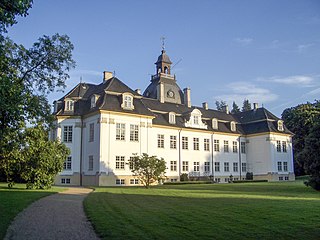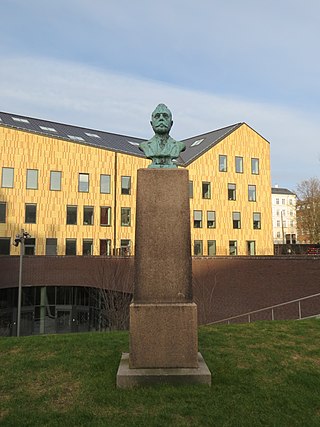
Axel Gabriel Erik Mørch better known as Gabriel Axel was a Danish film director, actor, writer and producer, best known for Babette's Feast (1987), which he wrote and directed.

Charlottenlund Palace is a former royal summer residence in Charlottenlund, some 10 km (6 mi) north of central Copenhagen, Denmark. The palace was named after Princess Charlotte Amalie, who was responsible for the construction of the original palace. It was later extended and adapted for Crown Prince Frederick VIII to a design by Ferdinand Meldahl in the early 1880s.

The Jutland horse is a draft horse breed originating in Denmark, named after the Jutland Peninsula which forms the western part of the country. Usually chestnut, they are a compact, muscular breed known for their calm and willing temperament. The breed was originally developed for use in agriculture, but today is more often seen in urban settings and at horse shows. Some of the best known members of the breed pull beer wagons for the Carlsberg brewery around Copenhagen, as well as at competitions and for demonstrations. Images from the 9th century show a horse similar to the Jutland being used by Viking raiders in what is now Great Britain. The first written record is from the 12th century, when they were popular as war horses. Some infusion of bloodlines from other breeds occurred in the 18th century, but the modern Jutland type only began about 1850 with the addition of blood from several other breeds, mainly draft horses. A stud book was created in the late 19th century, and the Jutland population grew to a maximum around 15,000 by 1950. Numbers subsequently declined, and as of 2011, only an estimated 1,000 horses remained.
Pétur Tryggvi Hjalmarsson was an Icelandic gold and silversmith.

Karen Clemmensen was a Danish architect and designer. The firm she set up with her husband Ebbe designed both traditional and more modern Functionalist buildings. Often inspired by Japanese and American trends, their work includes Kildeskovshallen in Gentofte and LO-skolen in Helsingør.

The Arp-Hansen Hotel Group is a hotel group based in Copenhagen, Denmark. The group has 12 hotels in Copenhagen and Aarhus.

The Danish author Louis Jensen was an innovator in the international literary trends of flash fiction, metafiction, prose poetry, and magical realism. While he published more than 90 books for both adults and children, he was best known for his children's books, which include picture books, short stories, flash fiction, creative nonfiction and novels. His work is characterized by wordplay and playful experiments in form and structure, which have led critics to draw comparisons to Borges, Calvino, Gogol, and the poetry of the Oulipo movement. His work is also rooted in the fairy tale and folk tale tradition, and is deeply influenced by the Danish author Hans Christian Andersen.

Jørgen Gudmundsen-Holmgreen was a Danish sculptor.
Anna Klindt Sørensen was a Danish painter and illustrator. She is now remembered as a strong, self-assured women who practised French Expressionism on her own terms in Denmark.
Elisabeth Dons Christensen is a Danish Lutheran theologian who served as bishop for the Diocese of Ribe from 2003 until her retirement in 2014 at the age of 70.
Dorte Dahlin is a Danish artist who entered the art scene in the early 1980s as part of the Wild Youth trend. She gained recognition from her participation in the 1982 exhibition Kniven på hovedet held at Tranegården in Gentofte. More recently, she has created decorative objects for churches.

Helen Sofie Dohlmann was a Danish sculptor.
Inger Frimann Hanmann was a Danish artist, specializing in painting and enamelwork. Her younger daughter Charlotte Hanmann is also a photographer, painter and graphic artist. Inger Hanman's best known enamel art works are displayed in Copenhagen Airport and Danske Bank.
Tove Thejll Clemmensen was a Danish art historian and curator who was a specialist in eighteenth-century Danish furniture. She renovated several Danish museums including Bakkehuset and Liselund in the 1950s.
Emilie Anna Maria Kornerup née Bruzelius (1918–2006) was a Swedish-Danish textile artist who specialized in embroidery and tapestry. She produced works for decorating public buildings and churches, including the Danish Parliament and Roskilde Cathedral. Kornerup was also active as a teacher with the Haandarbejdets Fremme textile guild and the Danish School of Arts and Crafts.

Anna Westergaard (1882–1964) was a Danish railway official and a highly influential women's rights activist. Working for the Danish State Railways where she later became a traffic supervisor, she became a board member of the Danish Railways Union (Jernbaneforeningen) and of the Danish Civil Servants Union. A strong proponent of equal rights for men and women in education and the labour market, she was a key contributor to management of the Danish Women's Society (1919–1924) and the Women's Council in Denmark (1938–1946). Westergaard represented Danish women's interests in discussions at the League of Nations in the mid-1930s. From 1937 to 1960, she was president of Open Door International for the Economic Emancipation of the Woman Worker. Politically, she belonged to the Danish Social Liberal Party and was an alternate in the Upper House or Landstinget from 1939 to 1953.
Jytte Reichstein Nilsson (1932–2020) was a Danish protozoologist and educator. She is remembered for her research into cell biology, undertaking electron-microscopic studies into cell structures, including the interplay between cell building and function. She served as vice-president of the Society of Protozoologists (1977), later becoming an honorary member. She contributed some 80 papers on her research to scientific journals.

Karen Kirstine Volf, also Wolff, née Hansen (1864–1946) was a Danish baker and pastry cook who in 1890 established a bakery in Hellerup, north of Copenhagen; this was unusual for a woman at that time and place. As a result of the popularity of her cakes and biscuits, by the early 1900s she was able to serve the whole of Copenhagen by introducing automobile-based deliveries. In the 1920s and 1930s, the business expended to the whole of Denmark with outlets throughout the country. Today her biscuits and cakes continue to be produced on an industrial scale as Karen Volf products by the Bisca establishment in Stege on the island of Møn.
Sofie Lippert Troelsen is a Danish politician and member of the Folketing, the national legislature. A member of the Green Left party, she has represented East Jutland since November 2022.

C. Schous Fabriker was a manufacturer and retailer of consumer products based in Copenhagen, Denmark. The company specialized in the production, distribution, and provision of household, health care, personal care, and associated products. In the 1920s, with more than 800 outlets, its chain of Schous Sæbehus shops was the largest of its kind in the country.












